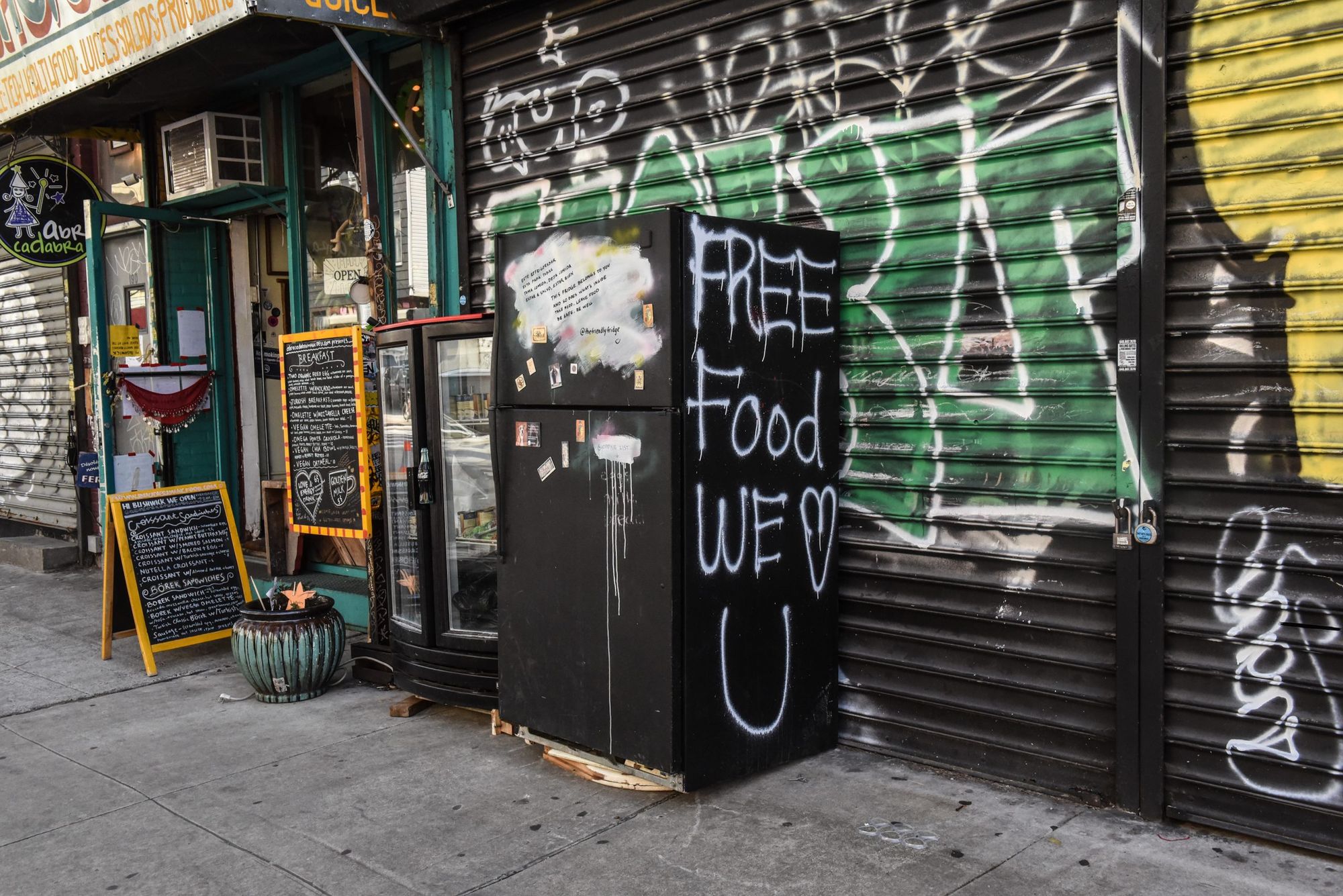Op-ed: Why Those Community Fridges Won’t Solve Hunger

Fridges stocked with free food are popping up in low-income neighborhoods—but they're part of a charity-based approach that isn't tapping into what residents actually want.
Community Fridges have been showing up in low-income neighborhoods around the country. Credited with “fighting food insecurity, reducing waste, and uniting neighbors,” these free-standing refrigerators are often placed outside apartment buildings, businesses, and bodegas, where they’re filled with donated food, free for whomever needs it.
They’ve also been celebrated all over the media, but if you dig a little deeper, however, you’ll find the fridges are merely an extension of the existing emergency food system, a system never designed to solve hunger.
It’s difficult to take a hardline stance against a good-natured effort—especially now, as unemployment rates in New York, Los Angeles, and other major cities hovers around 20 percent, and food insecurity has reached record levels. But the fridges and other charity-based projects run the risk of distracting from the long-term, community-based food sovereignty and food justice work that is already taking place.
As a food justice activist with a community-led approach, I’ve also found that the people installing these refrigerators don’t often represent the communities where they’re placed. Many of these organizers are relatively new to the food justice landscape, and they rarely seem to be asking residents what they need.
Meanwhile, some residents—like Stephanie Esquivel of Crown Heights—are more than a little skeptical. A self-proclaimed “prickly” person who is generally averse to community engagement, Esquivel saw a Facebook post about a fridge being placed in front of her building, and decided to weigh in.
“Still no extermination and last night the building was shot up, yet again. . . . This will not stop and we are facing a hot, hot summer,” she wrote, acknowledging the fact that even on her “radically gentrified” block, violence and landlord negligence are ongoing problems.
Esquivel had seen a sign about the fridge posted in the hallway, asking for resident input, while also acknowledging that the project had landlord approval. She was annoyed to see that the newer tenants in one of the renovated units had such reliable access to the landlord, when she couldn’t get him to attend to longstanding repairs. The building also had a rodent problem, and there hadn’t been any extermination for going on 10 years; she worried that the plan to install the “outdoor food pantry with fresh food” in the heat of the summer could make it worse.
Community fridges also exemplify a charity-based approach, says Andy Fisher, long time food security advocate and author of Big Hunger: The Unholy Alliance Between Corporate America and Anti-Hunger Groups.
While feeding the community is commonly framed as the solution to the food waste problem, Fisher says the charity-based approach is one that casts food as “an undifferentiated commodity.”
Fisher says “food is food is food is food,” is an idea that ignores the preferences of the charity’s intended recipients.
Meanwhile, he adds, hunger policy is often created in response to the nation’s surplus-heavy, profit-based agricultural industry. This dynamic is inherent in emergency food from its inception. Food is determined to be waste when someone no longer wants it.
The message to those on the receiving end of this charity, said Qiana Mickie, special projects consultant and former executive director of Just Food, is: “You are not worthy enough to know and make decisions about your food, just be happy it’s here.” These fridges are a symbol of a system built on distributing food deemed waste without asking the recipients if that’s what they want. It’s emblematic of all of our hunger policy, from the federal level to the city.
“The end consumer or the end business has no use for it,” said Mickie. “Essentially, [companies are] getting a tax break off waste by giving it to people in need. It looks like food, but what kind of food is it? Is it food the community needs? Is it food the community wants?”
These questions sit in tension with the current moment’s renewed attention to emergency food, as late-night hosts sit in their living rooms, soliciting donations for both food banks and food “rescue” organizations. New York’s state government has played a part: In May, Governor Andrew Cuomo launched the Nourish NY initiative to address agricultural excess resulting from the sudden loss of sales to schools, institutions, workplaces, and restaurants.
Funding went directly to emergency food providers to help them buy food from hurting local farms, a shift in the approach that usually relies on donated surplus. In this way, Cuomo replicated the process of starting with surplus in the agricultural industry to address hunger and poverty. Rather than give money to those in need, or even to smaller- scale farms directly, he gave it to the food banks and pantries, and trusted that through their vast bureaucracies, the money and resources would trickle down.
Emergency food efforts that spring up overnight are not sustainable, as many of the so-called mutual aid efforts behind them use the rhetoric of community solidarity but show little accountability to the community. True mutual aid is a consistent presence in communities, not only during times of emergency, and involves reciprocity. The very nature of these efforts—one group giving, another group taking—make true mutual aid impossible.
Some of the groups involved have said that these efforts come out of “love,” with goals of “reparations” and Black liberation, but that doesn’t change the actual model, which is pure charity. And with efforts that are charity-based, the hard labor done by volunteers to organize, aggregate, and transport food, form an unsustainable model, fueled by the privilege of time, energy, and millions in emergency food funds. What happens when volunteers are worn out or go back to work? Or when the state, city, and private foundation money runs out, but folks are still hungry?
“Emergency food is addressing immediate hunger, but immediate hunger has become persistent,” said Mickie. For any of these current efforts to actually benefit the community, she added, they would have to both address the root causes of hunger (poverty), and work to eventually put themselves out of business, instead of constantly being celebrated and growing. Otherwise, “you are making people reliant on something that’s not sustainable,” Mickie said.
There are ways to help those in immediate need with dignity and care, but doing so involves building relationships and talking to those who are already engaged in food sovereignty and food justice work. Organizations such as Neighbors Together, created a model, pre-COVID, that addresses the immediate need for food while working to organize participants to address the roots of hunger and homelessness.
Long standing community farms like Isabahlia Ladies of Elegance in Brownsville have adjusted and shifted to providing free fresh produce to the community. The Central Brooklyn Food Coop (of which I am a founding member) has fundraised to create Hold Down BK, which seeks to provide emergency food as they bring awareness of the long term goal of a community-owned grocery in Central Brooklyn. These groups all take an approach that involves being thoughtful about getting to know their neighbors, supporting them in ways they ask to be supported, and finding the best resources for that support. Yet the work of these long-standing efforts get little notice compared to the splashy coverage given to novel, flash-in-the-pan emergency food efforts.
Stephanie Esquivel exemplifies the need for longer-term structural change that really begins with centering those directly impacted by the economic downturn. She lost her job in March as a direct service provider, and landed a job managing a kitchen, returning to the hospitality industry, which she had worked in off and on for 20 years. Along with her concerns about pests, she worries about the temperature of the refrigerator, as different types of food are put there by volunteers.
She has noticed a racially diverse mix of people, mostly men, accessing the refrigerator and most haven’t been recognizable to her as neighbors. When I visited it on a recent day in July, the only things in the fridge were a bag of frozen French fries and a bunch of lettuce. It wasn’t clear how often it was being refilled or by whom and it didn’t look like there was not a lot of attention being paid to the type or condition of the food available.
Adela Wagner, one of the mutual aid organizers working in Crown Heights, said that it’s not being managed by anyone specific, but rather it’s “maintained and filled by people from the community, and supported by local businesses, farms, and individuals.” It was easy to see how interference or neglect could lead to contamination or illness.
But the true source of Esquivel’s frustration went deeper than food safety. It was the sense she got that community fridges aren’t being seen in the true context of the neighborhoods in which they’re being placed, and that resident’s priorities aren’t being heard. What was driving the anger underlying her response was the fact that, a few feet from where the fridge stands, a 25-year-old man was shot and murdered in early May.
She saw the original posting announcing the fridge on a queer exchange group on Facebook that used a photo taken at the site. “The very day of the biggest memorial, was the day [the fridge] was activated, and there were signs saying, ‘Hey, free food!’ I noticed the angle that the picture was taken, you couldn’t see any of the memorial, you couldn’t see what you were potentially walking into. It was completely tone deaf.”
Top Photos: A free food refrigerator stands on the sidewalk on May 5, 2020 in the Bushwick neighborhood in the Brooklyn borough in New York City. (Photo by Stephanie Keith/Getty Images)
By Rae Gomes is a mother, writer, food justice activist, and organizer based in Brooklyn, New York.
